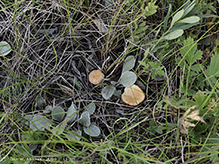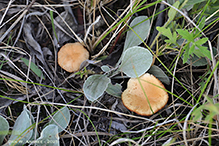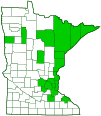Meadow Waxcap
(Cuphophyllus pratensis)
Conservation • Description • Habitat • Ecology • Distribution • Taxonomy
Conservation Status |
|||
| IUCN Red List | not listed |
||
| NatureServe | NNR - Unranked |
||
| Minnesota | not listed |
||
Description
Meadow Waxcap is a late season gilled mushroom. It is widespread, common, highly variable in size and shape, and somewhat variable in color. This has led to it being described many times under different names. It has also been moved to different genera several times. A recent phylogenetic study (Lodge et al., 2013) placed it in the genus Cuphophyllus, and that is where it remains today. In printed field guides and other literature, it may be found in the genus Hygrophorus, Camarophyllus, or Hygrocybe.
Meadow Waxcap occurs in North America, in Australia and New Zealand, and throughout Europe. In the United States and southern Canada, it occurs east of the Great Plains, in the Pacific Northwest, and on the West Coast of California. It appears from late spring through fall in other areas, but in Minnesota, all sightings have been from mid-July to early October. It is found in deciduous and coniferous forests, in thickets, and in fields and other grassy areas. It grows on the ground, alone, scattered, or grouped but not clustered (gregarious). The ecology is uncertain.
The cap can be ¾″ to 3½″ (2 to 9 cm) in diameter but is usually no more than 2⅜″ (6 cm) in diameter. When it first appears, it is dome-shaped or convex, not cone-shaped. It is reddish brown to orangish or brownish orange, darker towards the center. The upper surface is slightly sticky or greasy (viscid) to the touch but never slimy. It is covered with tiny, appressed fibers that are visible only under magnification. The margins are not lined. As it ages, the cap becomes broadly convex to almost flat, sometimes with the margins uplifted. The color fades to orangish buff, salmon buff, pinkish tan, or buff, and the margins slowly fade to white. The mature cap is dry and almost flat or slightly depressed. The upper surface is dry, smooth, and bald. On older caps, it sometimes cracks at the center.
The gills are soft, thick, broad, somewhat waxy, and spaced moderately far apart. They are colored like the cap or pale orange, salmon buff, to nearly white. They slightly run down the stalk. Between adjacent primary gills there are shorter gills that do not reach the stalk. At maturity, there are often cross-veins as well.
The stalk can be ¾″ to 4″ (2 to 10 cm) long and 3⁄16″ to ¾″ (5 to 20 mm) thick, but it is usually no more than 1¾″ (4.5 cm) long. It may be the same size from top to bottom or slightly tapered toward the bottom. The surface may be hairless or covered with fine, hair-like fibers (fibrilose). It is whitish or tinged with the color of the cap. There is no ring on the stalk.
The flesh is whitish or tinged with the cap color. It does not change color when sliced. It is edible but it is often infested with maggots.
The spore print is white.
Similar Species
Habitat and Hosts
Deciduous and coniferous forests, thickets, fields, and other grassy areas
Ecology
Season
Mid-July to early October in Minnesota
Distribution |
||
|
Sources Biodiversity occurrence data published by: Minnesota Biodiversity Atlas (accessed through the Minnesota Biodiversity Atlas Portal, bellatlas.umn.edu, 10/13/2025). |
|
| 10/13/2025 | ||
Occurrence |
||
Common and widespread |
||
Taxonomy
Kingdom
Fungi (Fungi)
Subkingdom
Dikarya
Phylum
Basidiomycota (Basidiomycete Fungi)
Subphylum
Agaricomycotina (Higher Basidiomycetes)
Class
Agaricomycetes (Mushrooms, Bracket Fungi, Puffballs, and Allies)
Subclass
Agaricomycetidae
Order
Agaricales (Common Gilled Mushrooms and Allies)
Suborder
Hygrophorineae
Family
Hygrophoraceae (waxcaps and allies)
Subfamily
Cuphophylloideae
Genus
Cuphophyllus (waxcaps)
Section
Cuphophyllus
Subordinate Taxa
Several varieties have been described, but listings do not always include the same varietal names. MycoBank and iNaturalist list six varieties. GBIF lists two varieties, neither of which appear on the MycoBank or iNaturalist.org lists. Index Fungorum recognizes no varieties, listing all of the varietal names as synonyms.
Pale individuals have been listed as var. pallidus and var. palidifolius. These occur throughout the range of the species. The fruiting bodies do not decay rapidly, so encounters with old faded specimens in good condition are common, leading the observer to believe they have one of the pale varieties.
Synonyms
Agaricus ficoides
Agaricus ficoides ssp. meisneriensis
Agaricus ficoides ssp. vitulinus
Agaricus ficoides var. meisneriensis
Agaricus pratensis
Agaricus pratensis ssp. meisneriensis
Agaricus pratensis ssp. vitulinus
Agaricus pratensis var. australis
Agaricus pratensis var. chalazinus
Agaricus pratensis var. communis
Agaricus pratensis var. ericosus
Agaricus pratensis var. ficoides
Agaricus pratensis var. grossus
Agaricus pratensis var. sericolor
Agaricus pratensis var. stirines
Agaricus pratensis var. subflavescens
Agaricus pratensis var. vitulinus
Agaricus vitulinus
Camarophyllus berkeleyanus
Camarophyllus berkeley
Camarophyllus bicolor
Camarophyllus ficoides
Camarophyllus ficoroides
Camarophyllus ortonii
Camarophyllus pratensis
Camarophyllus pratensis var. fulvolamellatus
Camarophyllus pratensis var. gracilis
Camarophyllus pratensis var. pallidus
Cuphophyllus berkeleyi
Cuphophyllus pratensis
Cuphophyllus pratensis var. donadinii
Cuphophyllus pratensis var. fulvolamellatus
Cuphophyllus pratensis var. pallidus
Cuphophyllus pratensis var. pratensis
Cuphophyllus pratensis var. robustus
Cuphophyllus pratensis var. vitulinus
Gymnopus pratensis ssp. vitulinus
Gymnopus pratensis var. vitulinus
Hydrocybe pratensis
Hygrocybe berkeleyana
Hygrocybe berkeleyi
Hygrocybe ortonii
Hygrocybe pallida
Hygrocybe pratensis
Hygrocybe pratensis var. donadinii
Hygrocybe pratensis var. pallida
Hygrocybe pratensis var. pratensis
Hygrocybe pratensis var. robusta
Hygrocybe pratensis var. vitulina
Hygrophorus berkeleyi
Hygrophorus bicolor
Hygrophorus ficoides
Hygrophorus ficoroides
Hygrophorus karstenii
Hygrophorus ortonii
Hygrophorus pratensis
Hygrophorus pratensis ssp. silvaticus
Hygrophorus pratensis var. meisneriensis
Hygrophorus pratensis var. minor
Hygrophorus pratensis var. pallidus
Hygrophorus pratensis var. robustus
Hygrophorus pratensis var. umbrinus
Hygrophorus pratensis var. vitulinus
Hygrophorus pratensns var. pallidus
Limacium karstenii
Psalliota pratensis
Common Names
Butter Meadowcap
Meadow Waxcap
Meadow Waxy cap
Meadow Waxycap
Meadow Waxgill
Glossary
Fibrillose
On mushrooms, covered with fine hair-like fibers.
Gregarious
In mushrooms, growing close together but not clustered.
Not Saprobic
Hygrocybe and former Hygrocybe mushrooms were long thought to get their nutrients from dead or decaying organic matter (saprobic). This is now known to be untrue. However, the hosts and type of partnerships to those hosts remains unclear.
Visitor Photos
Share your photo of this fungus.
This button not working for you?
Simply email us at info@MinnesotaSeasons.com.
Attach one or more photos and, if you like, a caption.
Dan W. Andree |
||
Some kind of small mushrooms... These were at Frenchman's Bluff SNA 7-8-25. They were real small one was maybe 1/2 - 3/4 inch the larger one maybe an 1.25 in or so. They had gills I looked under on but didn't get any photos of the underneath. Just these two didn't see any others. |
||
 |
 |
|
MinnesotaSeasons.com Photos
|

Slideshows
Cuphophyllus pratensis
Mushrooms Fungi
Cuphophyllus pratensis - fungi kingdom
Fungi Kingdom

Visitor Videos
Share your video of this fungus.
This button not working for you?
Simply email us at info@MinnesotaSeasons.com.
Attach a video, a YouTube link, or a cloud storage link.
Other Videos
Identifying the Meadow Waxcap, Cuphophyllus pratensis
Wild Food in the UK Ltd
Cuphophyllus pratensis - Hygrophorus pratensis - Meadow Waxcap
The wonderful world of mycology

Visitor Sightings
Report a sighting of this fungus.
This button not working for you?
Simply email us at info@MinnesotaSeasons.com.
Be sure to include a location.
Dan W. Andree
7/8/2025
Location: Frenchman’s Bluff SNA
These were at Frenchman's Bluff SNA 7-8-25. They were real small one was maybe 1/2 - 3/4 inch the larger one maybe an 1.25 in or so.
They had gills I looked under on but didn't get any photos of the underneath.
Just these two didn't see any others.
MinnesotaSeasons.com Sightings |
|


